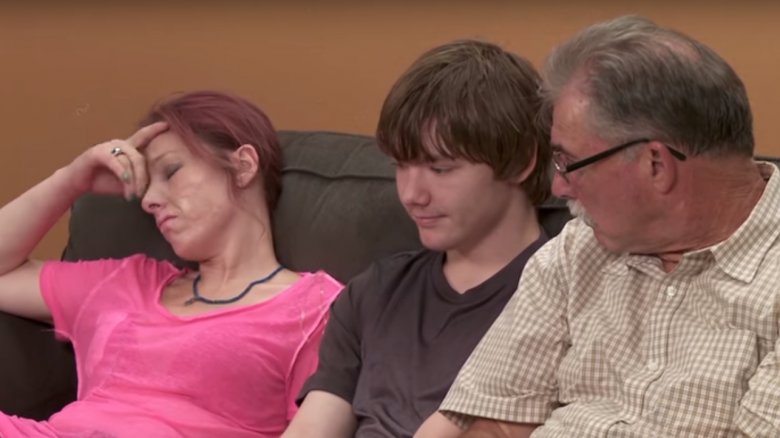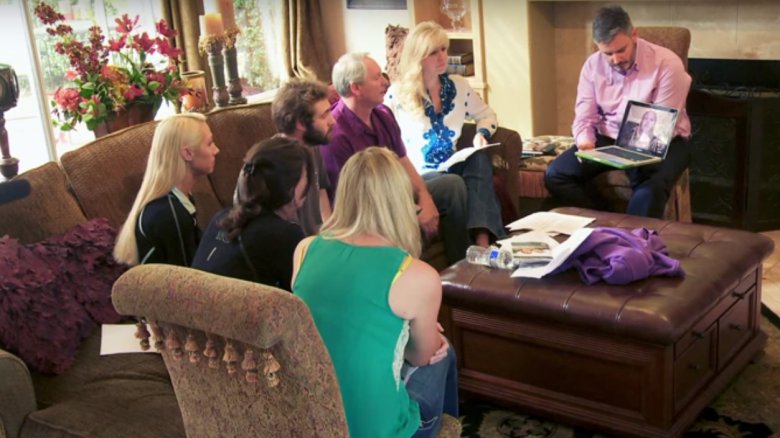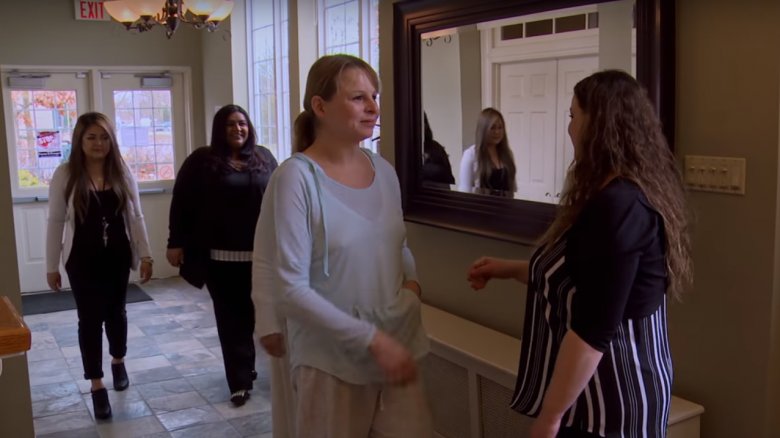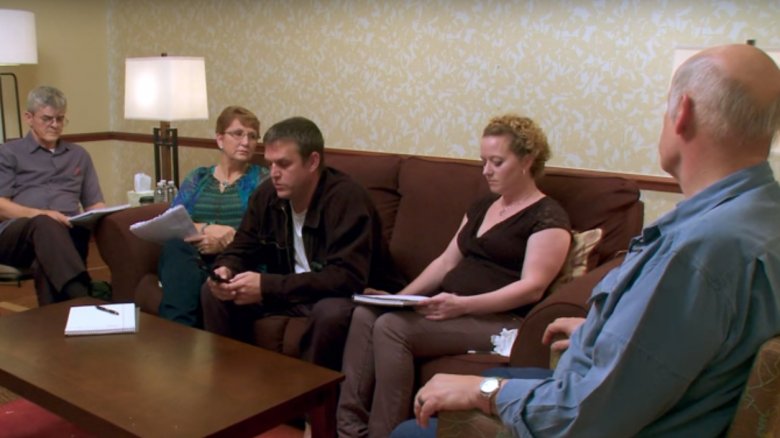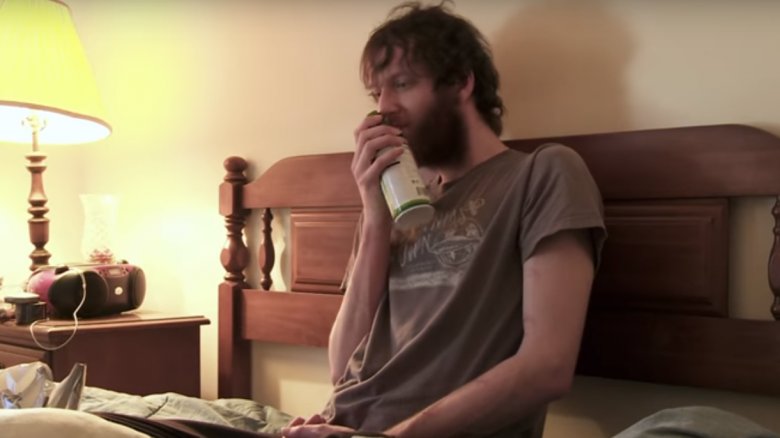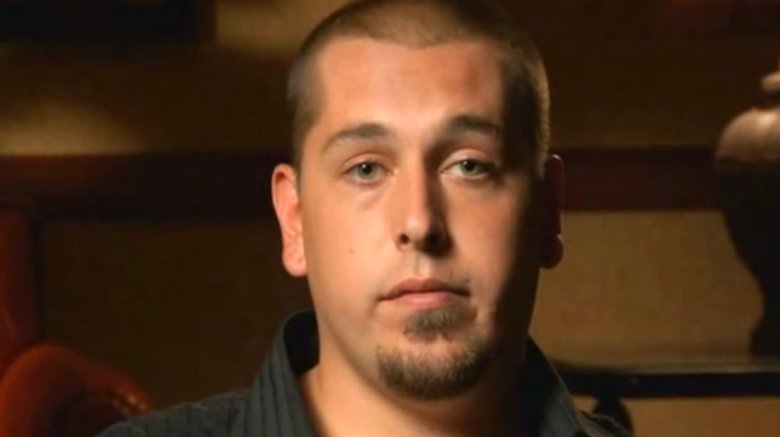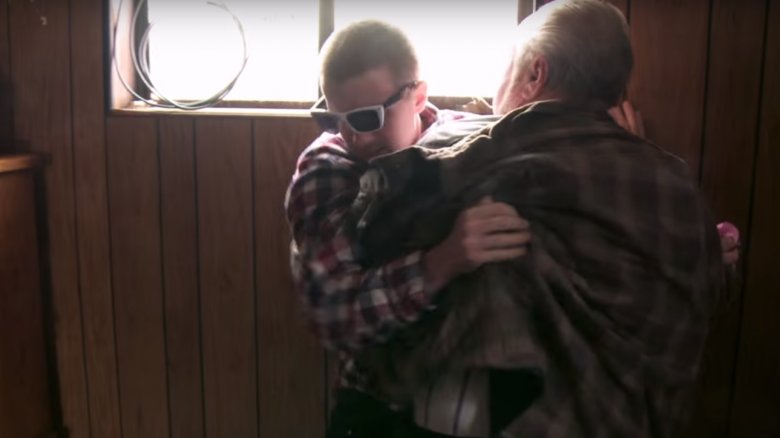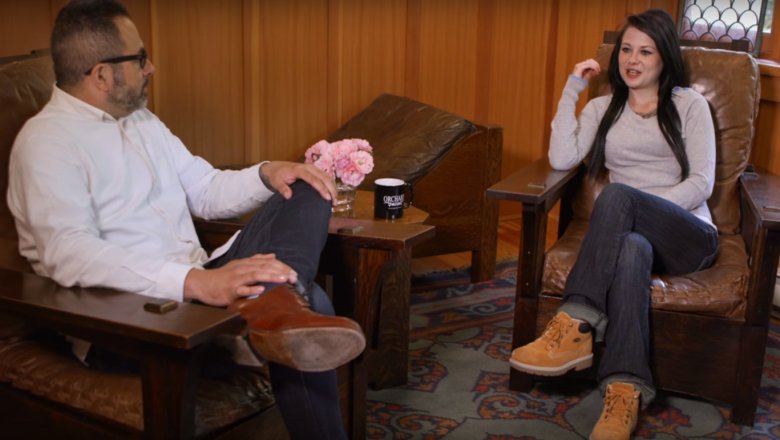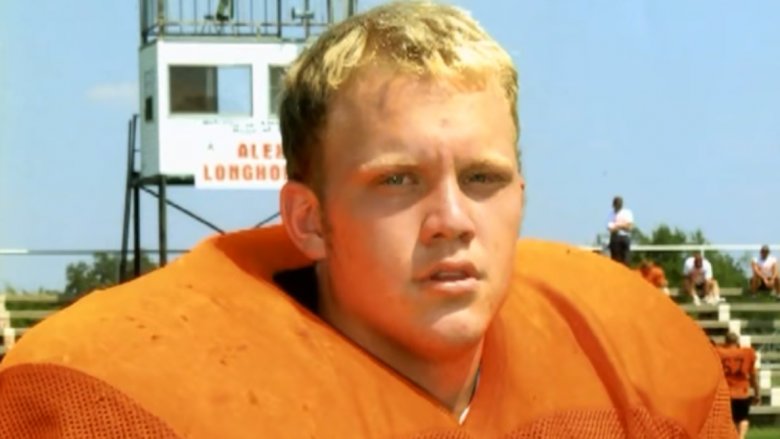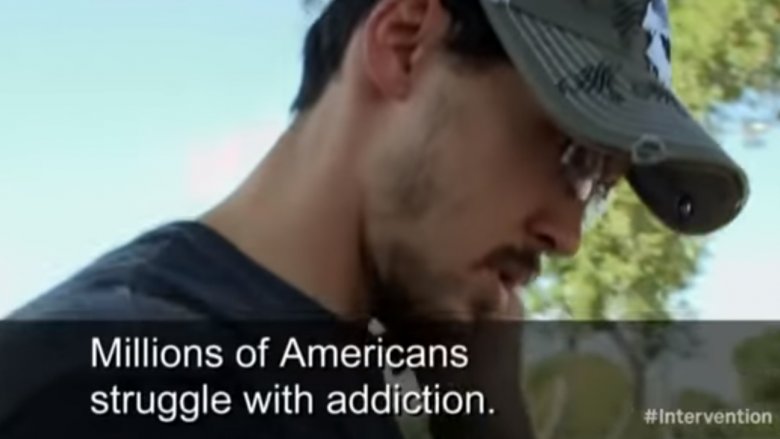The Disturbing Untold Truth Of Intervention
Since its debut on A&E in 2005, Intervention has cast a much-needed spotlight on drug and alcohol addiction and excessive usage in the United States. The Emmy award-winning show has helped many people who suffer from addiction, as well as the families and friends of those individuals, but it is not without its share of controversy.
While public interest in the show has allowed it to stay on the air for more than a decade — even surviving cancellation in 2013 — some critics have questioned the show's exploitative premise. Season 20, for example, centered on Philadelphia's opioid crisis, but was swiftly criticized by addiction experts in the city as it aired in 2019, per The Philadelphia Inquirer. While advocate Brooke Feldman explained, "It's a reality TV show — it's meant to be dramatic, and sensationalizes what is really a health condition," Devin Reaves of the Pennsylvania Harm Reduction Coalition claimed, "It doesn't feel like it's there to help our individual community." Needless to say, both declined requests to participate on Intervention.
There are also concerns about the treatment methods used on the show, the narrative structure, and its impact on the public. Even the series' recovery numbers have been called into question. Despite bringing attention to addiction and its impact on those affected by it, the concerns surrounding this series deserve a closer look. This is the disturbing untold truth of Intervention.
If you or someone you know is struggling with substance abuse and mental health, please contact SAMHSA's 24-hour National Helpline at 1-800-662-HELP (4357).
Are Intervention's methods outdated?
The type of intervention used by the professionals on Intervention is called the Johnson Model. Created in the 1970s by a priest, Dr. Vernon Johnson, the model employs family members to write personal letters to their suffering loved ones. As seen in the show, these letters highlight the consequences of the individual's addiction and present ultimatums for the user.
Though this style of intervention is well-known, largely because of the show, some experts consider it outdated. Critics suggest the Johnson Model results in a high number of addicted individuals agreeing to enter treatment, but the number of early exits and relapses are also high. According to Psychology Today, the confrontational, aggressive, and combative tactics employed by the Johnson Model may coerce individuals to enter treatment without the necessary "internalized motivation to quit."
Alternatively, more modern approaches are available to the families and support workers trying to help people suffering from addiction. Motivational Interviewing, for example, is a strategy used to help the individual find the internal motivation necessary to enter, complete, and commit to the long-term recovery process.
A hidden agenda for rehab centers
For sharing their lives with Intervention and the public, participants receive some of the best treatment money can buy — a 90-day stay at a reputable rehabilitation center. According to the Daily Beast, the appropriate center is chosen by the show's facility liaison, and the treatment prices range from $50,000 to $120,000. But even in this upper echelon of treatment centers, there are still some bad seeds.
According to Vice, A Sober Way Home, a now-closed for-profit facility out of Arizona, which was "featured on several of the Intervention episodes," reportedly emphasized a policy of "keeping heads on beds" above all else, rather than taking in only qualified patients. This led to trouble in 2011, when a patient named Brandon Jacques was reportedly admitted to the center for alcohol issues and bulimia. Despite assuring the family "it could treat Brandon's dual disorders" upon admittance, A Sober Way Home revealed it "could not properly treat [Brandon's] eating disorder" a month later.
The center then encouraged Brandon to attend (and pay) another center in California called Morningside. According to a former Morningside employee, despite anti-kickback laws, these two facilities "were making referrals back and forth," resulting in bonuses for each, reported Vice. Brandon was later transferred to a third facility (without his family knowing) that was not equipped to treat him. At that facility, called The First House, he went into cardiac arrest and later died.
Are Intervention's participants ready (or not) for rehab?
One of the concerns critics raise about Intervention is that participants may be pressured into treatment rather than freely choosing to pursue help. According to several studies, that choice could be the difference between relapse and long-term recovery, because experts believe there is a correlation between success and an "internal desire to reduce or change addictive behavior."
Alan Cudmore, a program consultant with the Centre for Addiction and Mental Health in Ontario, argues that the coercion methods employed on Intervention indicate how seriously the on-show experts "misunderstand how human beings change," asserting that "ambivalence is the normal human response to the pressure to change." Citing the work of clinical psychologist and researcher Bill Miller, Cudmore asserts that when ultimatums and threats are "intentionally sprung on people in the structured intervention approach," the results can be detrimental because "surprise attacks" may "increase, rather than decrease, people's resistance."
While it may appear that the Johnson Model has produced beneficial results on the show, clinical trials have shown these methods to be ineffective. According to a study by Miller and William Lee White, "Four decades of research have failed to yield a single clinical trial showing efficacy of confrontational counseling, whereas a number have documented harmful effects, particularly for more vulnerable populations."
Relapsing is extremely dangerous
When a person struggling with addiction agrees to treatment — something that occurs in the majority of cases on Intervention — he or she should be fully committed to the entire recovery process in order to be successful. Attending an all-expenses paid trip to rehab without actually desiring to become sober creates the risk for more than just an early exit and a depleted will to quit in the future. For many, relapsing can be fatal.
Drug abuse counselor Dave Malloy told the Daily Beast that "people who die of overdoses ... were most likely recently in rehab or jail." This is because, according to The Treatment Center, "Whether someone spends a month or six months without a habitual drug, the body starts to change. As normal processes resume, the brain loses its tolerance for the ever-increasing opioid doses that often precede rehabilitation." If the patient later relapses, he or she may "use the same dose they took prior to treatment," an amount that may now prove deadly.
Because of this, it is vital that a person entering treatment is prepared for the challenges both during and after rehabilitation.
All those post-Intervention deaths
While Intervention has, no doubt, helped rehabilitate many people suffering from addiction, there have been some dark spots in the show's history.
According to the Just Believe Recovery Center, more than 30 people featured on the show have died since their TV appearances, and at least eight former subjects reportedly died from overdoses after appearing on the show. Two others died from possible drug use. Of the aforementioned eight, seven were supposedly addicted to opioids.
It's commendable that the show tries to help people, but for many participants, that assistance was arguably too little too late. Though it may be impossible to prevent all relapses, the team at Intervention could perhaps place more emphasis on the preparedness of the individuals entering rehab to better ensure they are committed to the entire recovery process.
Intervention has been criticized for 'shock value' over professionalism
Though most professionals on Intervention treat their subjects with respect, there have been moments that seem unnecessarily exploitative. The show is clearly in the business of entertainment, so some manufactured drama is to be expected, but the series' basic structure appears designed to value the negative more than the positive.
Did you notice that episodes often seem to concentrate more on the addiction and less on the recovery process? "Americans like to see people on fire," said Michael Walsh, president of the National Association of Addiction Treatment Providers (via Addiction Professional). By highlighting the angst and then staging a confrontational intervention, the show essentially throws gasoline on that fire.
Walsh argues that Intervention strives for "shock value" over professionalism. He points to one episode in which a past sexual assault is brought up during the intervention for no apparent reason. "The family didn't need to know this," Walsh said. "And I certainly didn't need to know it watching it on national television. A licensed professional shouldn't have done this." Though it creates drama for the TV audience, bringing up a past trauma for no therapeutic reason could trigger the victim and backfire horrendously.
Intervention might suggest that recovery is the easy part
Intervention is structured in a way that allows the viewing audience to see the consequences of addiction without experiencing it personally. Think of it as addiction tourism. To appease its audience, Intervention shows the addict's life falling apart for the vast majority of the show. Then, during the final moments, we learn about the recovery. This structure is problematic for many because it suggests that the recovery — perhaps the hardest part of the journey — is the easy part.
According to Alta Mira Recovery Programs, "There are no shortcuts to recovery." The journey can be long and extremely challenging. By essentially fast-forwarding or altogether eliminating this part of the process from the show, Intervention runs the risk of misleading its audience.
There are other issues, as well. According to Joyce Pines for the Kalamazoo Gazette, securing treatment can be a challenge for many people. While Intervention pays for a 90-day stay for the show's participants, that length of treatment would be wildly expensive in real life. "Some insurance companies cap residential treatment benefits at 30 days for a person's lifetime," said Pines. "Typically, people get eight to 15 days of residential services at one time, either through private insurance or public grants."
Intervention's curious recovery numbers
Reviewing the rehabilitation rates reported by Intervention producers begs some serious questions. According to the Daily Beast (via Reality Blurred), the show claimed in 2010 that 130 of its 161 participants had remained sober — that equates to an 71 percent success rate. Three years later, that success rate had dropped to 64 percent. Then, in 2015, it was reportedly 55 percent. While some may look at the decreasing number and see a problem, these rates are still exceptional. So exceptional, in fact, that they raise eyebrows.
Alcoholics Anonymous, for example, posts success rates of 27 percent within one year, 24 percent between one and five years, and 13 percent between five and ten years. However, some studies argue that the AA success rate is actually somewhere between 5 percent and 10 percent. It seems rather odd that Intervention could achieve such a significantly higher rate of success.
In an interview with Business Insider, showrunner Jeff Weaver argues that Intervention's extraordinary numbers may be because of the show's structure, which essentially gives participants a "head start" on the process. "When our subjects say yes to treatment, they've just undergone an intense documentary process where they're asked hard hitting, deeply personal questions about every aspect of their lives," Weaver said.
While plausible, this answer doesn't explain how Intervention tracks its results. The Division on Addictions reportedly tried to get clarification on the show's tracking process to explore the possibility that its success rates are "mistakenly high," but it did not receive a response.
Intervention and the concept of 'wasted whiteness'
One of the criticisms of Intervention, at least in academic discourse, is how the show frames addiction in relation to "whiteness." Not only are the show's subjects primarily white (87 percent as of 2012), but according to Jessie Daniels from the City University of New York, even when dealing with a person who is not white, "The producers of Intervention present a narrative of addiction that is embedded in a white racial frame." This, Daniels argues, creates a concept of "wasted whiteness" for the audience.
The overarching structure of the show is usually the same. The subject grew up in a happy (usually white) world surrounded by opportunity. Viewers are bombarded with pictures and videos from this happy time. Then the happiness disintegrates, and the opportunities crumble as addiction takes over.
As an article on Hazlitt describes, "[The subject's] life is ugly, but not so ugly that you turn away. She's sad, but just sad enough to be engaging. She's her own worst enemy, but not to the extent that she becomes unsympathetic. As viewers, we get both a sense of superiority in watching her bottom out, and a sense of satisfaction in watching her get better."
Daniels argues that Intervention not only exploits the picture of the idealized sufferer — one deserving of rehabilitation and our empathy — but also compounds a bigger issue by strengthening the imaginary divide between deserving white addicts and the undeserving "other."
Does Intervention open with a lie?
Most episodes of Intervention open with the same line: "Millions of Americans struggle with addiction. Most need help to stop." While this may sound plausible, it's actually quite misleading. According to various studies (via The Clean Slate), most recovering addicts do not receive help to achieve sobriety.
In a study done by the National Institute on Alcohol Abuse and Alcoholism, 75 percent of addicts who reached sobriety did so without any help at all. The other 25 percent received help, but there is no evidence to suggest they couldn't have recovered without it. According to Addiction.com, "Only about 12 percent of people with alcohol dependence ever receive specialty alcohol treatment." The truth is, the vast majority of people who overcome substance abuse, do so through what is called "spontaneous or natural remission or recovery."
While the opening line on Intervention should not be viewed as particularly harmful, it might be time for an amendment. Receiving help is certainly welcome for many people suffering from addiction, but sobriety can be achieved in many different ways and we shouldn't discount other avenues of recovery.

